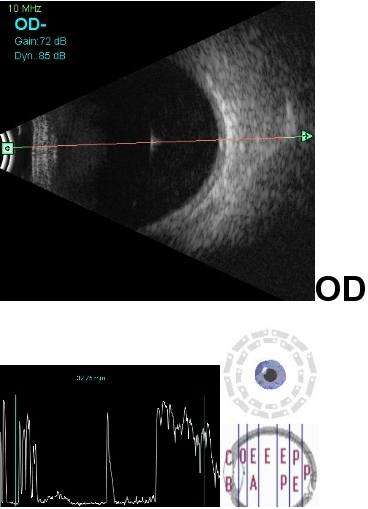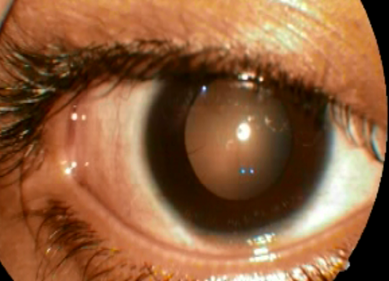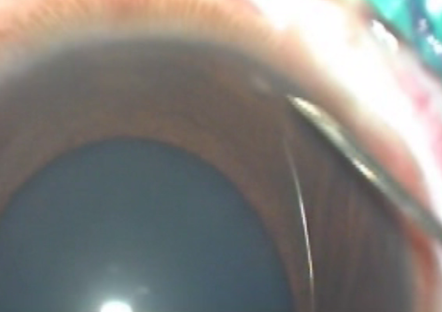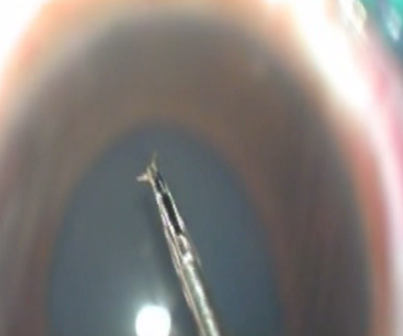Case Report
Volume 1 Issue 1 - 2019
Multiple Intraocular Caterpillar Hairs
JPM Rotary Eye Hospital & Research Institute, Sec-6, CDA, Bidanasi, Cuttack, Orissa-753014, India
*Corresponding Author: Dr. Santosh Kumar Mahapatra, Chief Medical Officer, JPM Rotary Eye Hospital & Research Institute, Sec-6, CDA, Bidanasi, Cuttack, Orissa-753014, India.
Received: September 01, 2019; Published: September 10, 2019
PURPOSE : To present a case of non-subsiding intraocular inflammation with gross diminution of vision of more than three months duration due to presence of multiple intraocular caterpillar hairs.
SETTING: A 19 year old male presenting to a tertiary eye care centre in eastern India with multiple intraocular caterpillar hairs. Here we present a case of non-subsiding intraocular inflammation for more than three months with intra corneal, intra cameral, intra lenticular and intravitreal caterpillar hairs which were surgically removed successfully.
CASE: A 19 year old male presented to our hospital with the complaints of pain, redness and blurred vision in his right eye for three months. He was being treated with topical steroid for anterior uveitis during the same period, without any significant improvement. His BCVA was 5/60 and 6/6 in his right eye and left eye respectively. Examination of left eye showed no abnormality. Slit lamp examination of right eye revealed corneal infiltrate at 7 o'clock position and, grade 2 cells and flare in anterior chamber. Fundoscopy showed vitreous haze with a refractile structure in mid vitreous cavity. B-Scan revealed presence of a thin linear foreign body in the vitreous cavity with a corresponding high spike echo suggestive of intravitreal caterpillar setae. Further examination revealed presence of caterpillar hair in cornea at 7 o'clock, at 5 o'clock position in anterior chamber and in lens at 2 o'clock position. Caterpillar hair from the cornea and anterior chamber were removed under microscope in the same sitting of pars plana vitrectomy. The intracameral caterpillar hair was grasped with vitreous forcep after filling anterior chamber with viscoelastic and removed through the side port. The intravitreal caterpillar hair was removed with the vitrectomy cutter port as it was impossible to grasp the caterpillar hair with vitreous forceps. The intralenticular seta was left behind as it was inside the lens matter without causing any inflammation and the lens was clear. After removal of multiple caterpillar setae the patient was treated with topical and oral steroid. There was subsidence of inflammation with improvement in vision to 6/9 at the end of 6 weeks. He had no recurrence of intraocular inflammation and lens remained clear at 1 year of follow up.

Figure 2: B Scan Showing Intravitreal CP Hair with corresponding high hyperreflective spike on A Scan overlay.
Discussion
The prevalence of caterpillar hair induced ophthalmitis (CHIO) is high in this part of the world as population is more exposed to agricultural circumstances. It is very difficult to remove the hair in all instances due to their extreme friability, accompanying corneal edema, surrounding infiltration, and deep lying hair. Most patients have more than one hair, all of which may not be amenable for removal at the first sitting. Thus, patients with retained intracorneal hair must be followed up closely as vision-threatening complications may develop late in the course of the disease.
Pathophysiology of inflammation is assumed to be both partially mechanical2 (progression caused by distal end oriented barbs on setae) and partly toxic [1,2,3] (thymetopoien secreted from the venum gland connected to the hair shaft). A number of theories have been postulated suggesting possible mechanism of migration of setae. [4,5] Gunderson et al. [4] suggested that because the setae have no propulsive power of their own, movements of the globe with versions, respirations and pulse together with the constant iris movement propel the spines (on the setae) forward. It can be seen from the electron micrographs that the direction of the spines is vital in this, allowing only forward movements.
This case highlights the value of a careful ocular examination and proper history-taking in a case of non-resolving uveitis which helped us to reach at an accurate diagnosis. The treatment emphasizes on meticulous removal of all caterpillar hairs along with anti-inflammatory medications as required. Phacoemulsification with steroid cover and periodic follow- up in the management of cataractous lens associated with intralenticular setae is of potential value in such eyes.
Conclusion
Though caterpillar hairs on ocular surface are common, intraocular caterpillar hair is rare and intravitreal caterpillar hair is even rarer. CHIO is an inflammatory response of ocular tissue to caterpillar hair/other insect hair that come in contact with the eye. It is usually an innocuous condition responding well to conservative management. However, in some cases there is intraocular penetration of CP hair resulting in uveitis, vitritis, intralenticular abscess and even endophthalmitis which need careful observation and meticulous management.
References
- Steele C, Lucas DR, Ridgway AE. (1984). Endophthalmitis due to caterpillar setae: Surgical removal and electron microscopic appearance of the setae. Br J Ophthalmol 68:284–8.
- Lamy M, Pastureaud MH, Novak F, Ducombs G, Vincendeau P, Maleville J, et al. (1986). Thaumetopoein: An urticating protein from the hairs and integument of the pine processionary caterpillar (Thaumetopoea pityocampa Schiff, Lepidoptera, Thaumetopoeidae). Toxicon 24:347–56.
- Horng CT, Chou PI, Liang JB. (2000). Caterpillar setae in the deep cornea and anterior chamber. Am J Ophthalmol 129: 384–5.
- Gundersen T, Heath P, Garron LK. (1951). Ophthalmia nodosa. Trans Am Ophthalmol Soc 151–69.
- Ascher KW. (1968). Mechanism of locomotion observed on caterpillar hairs. Br J Ophthalmol 52: 210.
Citation: Anuja Mohanty and Santosh Kumar Mahapatra. (2019). Multiple Intraocular Caterpillar Hairs. Journal of Ophthalmology and Vision Research 1(1).
Copyright: © 2019 Santosh Kumar Mahapatra. This is an open-access article distributed under the terms of the Creative Commons Attribution License, which permits unrestricted use, distribution, and reproduction in any medium, provided the original author and source are credited.



